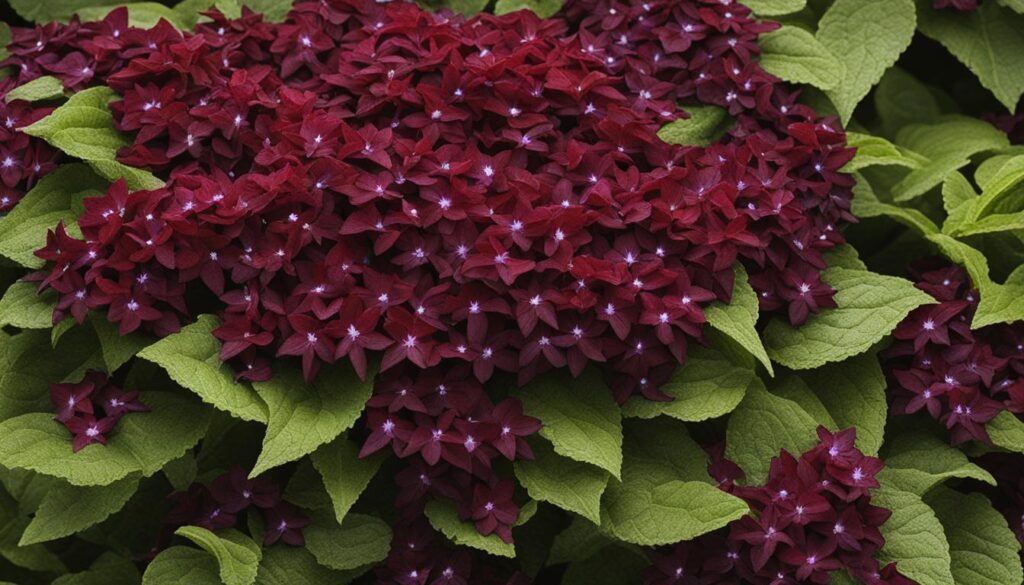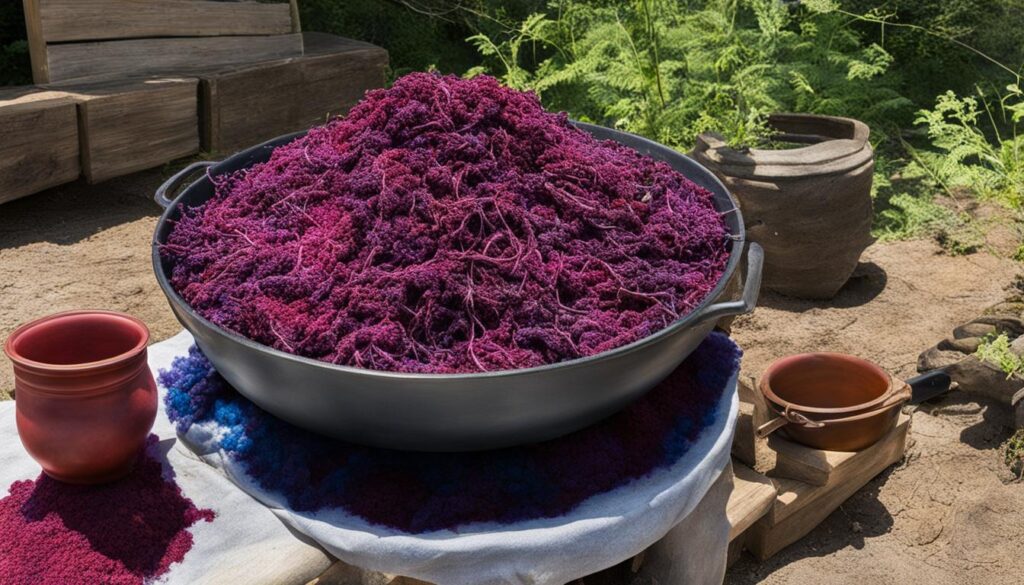Welcome to my article on the uses and benefits of alkanet root. Alkanet root, scientifically known as Alkanna tinctoria, is a versatile plant that has been used for various purposes throughout history. It is commonly known as alkanet and has been valued for its natural dyeing properties, herbal remedies, and skincare benefits.
Alkanet root is renowned for its ability to provide relief from inflammation and soothe the skin. It contains key components such as pyrrolizidine alkaloids and naphthazarin, which contribute to its medicinal properties. These components make alkanet root a natural remedy for addressing various skin conditions and providing soothing effects. Additionally, alkanet root is widely recognized for its natural colorant properties, making it a sought-after ingredient in the production of cosmetics and personal care products.
However, it is important to approach alkanet root usage with caution due to the potential liver and lung toxicity caused by the pyrrolizidine alkaloids it contains. It is always advisable to use alkanet root products sparingly and in accordance with recommended guidelines.
Key Takeaways:
- Alkanet root is a versatile plant known for its natural dyeing properties, herbal remedies, and skincare benefits.
- It contains pyrrolizidine alkaloids and naphthazarin, which contribute to its medicinal properties and soothing effects.
- Alkanet root is used as a natural colorant in the production of cosmetics and personal care products.
- Use alkanet root with caution as it may have potential liver and lung toxicity.
- Always follow recommended guidelines and consult a healthcare professional if needed.
A Brief History and Origin of Alkanet Root

Alkanet root has a fascinating history that spans back to ancient times, where it has been widely used for various purposes. This versatile plant, scientifically known as Alkanna tinctoria, has been an integral part of human culture for centuries.
Originating from southern Europe, alkanet root has a rich historical background. The Greeks, renowned for their extensive knowledge of herbs and plants, were among the first to recognize its value. Influential figures such as the Greek physician Hippocrates, often referred to as the “Father of Medicine,” and the renowned botanist Theophrastus, mentioned the use of alkanet root for treating skin ulcers and as a dye.
“Alkanet root has been revered for its medicinal and coloring properties for centuries. Its ancient usage by prominent figures in history highlights its importance and versatility.”
Traditionally, alkanet root was primarily used as a natural dye, imparting a vibrant red color to fabrics, fats, and oils. These dyeing properties made it a valuable commodity in the textile industry, adding a touch of elegance to clothing and textiles.
Furthermore, alkanet root has also held a significant place in traditional herbal medicine. Its medicinal properties were highly regarded, and it was used for various ailments and conditions. In addition to its use in skincare and wound healing, alkanet root was believed to possess other therapeutic benefits, though further research is needed to substantiate these claims.
Over time, alkanet root’s popularity has extended beyond traditional uses. Today, it is primarily employed as a cosmetic dye, lending its vibrant red color to a wide range of beauty and personal care products. Its rich history and diverse applications make alkanet root a remarkable ingredient that has transcended time and cultures.
Natural Usage of Alkanet Root Throughout History
Throughout history, alkanet root has been utilized in various intriguing ways. Here are some notable examples of its traditional uses:
| Traditional Use | Description |
|---|---|
| Textile Dyeing | The vibrant red color of alkanet root made it a prized natural dye for fabrics, creating visually stunning garments. |
| Fat and Oil Coloring | Alkanet root was used to impart a reddish tint to fats and oils, adding an appealing touch to culinary preparations and cosmetic formulations. |
| Medicinal Herb | Valued in traditional herbal medicine, alkanet root was believed to possess various healing properties. It was often used topically for skin conditions and wound healing. |
With its rich historical background and diverse applications, alkanet root continues to be cherished for its versatility and unique properties.
Stay tuned for the next section, where we’ll explore the properties and key components of alkanet root that contribute to its remarkable uses and benefits.
Properties and Key Components of Alkanet Root

Alkanet root possesses unique properties and includes key components that contribute to its therapeutic effects. One of the primary components found in alkanet root is naphthazarin, a red pigment responsible for its vibrant color. This pigment is primarily composed of fat-soluble naphthazarin compounds like alkannin and related esters. Furthermore, alkanet root contains pyrrolizidine alkaloids, known for their anti-inflammatory and antioxidant properties. Together, these key components synergistically deliver soothing and healing benefits to both the skin and the body.
Through its naphthazarin compounds, alkanet root presents a striking appearance and demonstrates its potential as a natural dye. The pyrrolizidine alkaloids found in alkanet root contribute to its anti-inflammatory properties, working to alleviate inflammation and provide relief. These alkaloids also exhibit antioxidant effects, which help combat the harmful effects of free radicals and oxidative stress on the body.
With its exceptional properties and key components, alkanet root has been widely utilized for skincare and medicinal purposes. Its ability to soothe and heal the skin, combined with its natural colorant properties, has made it a sought-after ingredient in various cosmetic and personal care products. Moreover, the anti-inflammatory and antioxidant effects of alkanet root make it a valuable resource in traditional herbal medicine.
| Naphthazarin Compounds | Pyrrolizidine Alkaloids |
|---|---|
| Contributes to the vibrant color of alkanet root | Exhibits anti-inflammatory properties |
| Mainly composed of fat-soluble naphthazarin compounds such as alkannin and related esters | Offers antioxidant effects |
Natural Usage of Alkanet Root

Alkanet root is a versatile ingredient with a wide range of natural uses in culinary, cosmetic, and personal care products. Its vibrant color and dyeing properties make it a valuable addition to various applications.
Culinary Uses
In the culinary world, alkanet root is used as a natural colorant to impart a vibrant red or purple hue to foods and beverages. From sauces and desserts to drinks and even savory dishes, alkanet root is employed to create visually appealing culinary creations.
Cosmetic Uses
Alkanet root plays a significant role in the cosmetic and personal care industry, where it is utilized in the production of soaps, lip balms, lotions, and other skincare products. Its natural dyeing properties not only add vibrant colors but also provide a sense of uniqueness and allure to these products.
Natural Dyeing
One of the most prominent uses of alkanet root is in natural dyeing. It has been a popular choice for centuries when it comes to dyeing fabrics, yarns, and clothing. Alkanet root produces stunning shades of red and purple, allowing for the creation of visually striking textiles.
| Culinary Uses | Cosmetic Uses | Natural Dyeing |
|---|---|---|
| Imparts vibrant colors to foods and beverages | Used in soaps, lip balms, and lotions | Creates beautiful shades of red and purple in fabrics |
| Provides visually appealing culinary creations | Adds unique and alluring hues to skincare products | Allows for the production of striking textiles |
Alkanet Root for Skincare

When it comes to skincare, alkanet root proves to be a valuable ingredient. Its soothing properties make it an excellent choice for calming irritated and inflamed skin. Whether you’re dealing with redness, swelling, or general discomfort, alkanet root’s anti-inflammatory effects can provide relief. But its benefits don’t stop there. Alkanet root also promotes skin healing, making it useful for speeding up the recovery process of wounds, burns, and skin abrasions. These remarkable skincare benefits have made alkanet root a popular ingredient in natural skincare products.
Harnessing the power of alkanet root, skincare products infused with this natural ingredient offer a gentle and effective solution for various skin concerns. If you’re looking for a natural remedy that can calm and repair your skin, consider incorporating alkanet root-infused products into your skincare routine.
“Alkanet root’s soothing and anti-inflammatory properties make it an excellent ingredient for relieving skin redness, swelling, and discomfort.”
Why Alkanet Root for Skincare?
What sets alkanet root apart from other skincare ingredients is its remarkable healing and anti-inflammatory properties. While many skincare products focus solely on surface-level improvements, alkanet root goes beyond that by addressing the root causes of skin concerns. Its natural ability to calm inflammation, coupled with its skin-healing properties, makes it a versatile and effective addition to any skincare routine.
Whether you’re dealing with sensitive skin, acne, eczema, or other skin conditions, alkanet root can help soothe and restore your skin’s health. It provides a natural and gentle alternative to harsh chemicals often found in conventional skincare products. The soothing effects of alkanet root can bring comfort to your skin, allowing it to heal and rejuvenate.
Integrating Alkanet Root into Your Skincare Routine
There are various ways to incorporate alkanet root into your skincare routine:
- Look for skincare products that include alkanet root as an ingredient.
- Create your own homemade skincare products using alkanet root-infused oils or extracts.
- Consider incorporating alkanet root powder into face masks or creams for a DIY skincare experience.
Remember, everyone’s skin is unique, so it’s essential to perform a patch test before using any new skincare product or ingredient. This step helps determine whether your skin will react positively to alkanet root or if it may cause any adverse reactions.
Embracing the Power of Alkanet Root
With its soothing and healing properties, alkanet root has become a go-to solution for those seeking natural skincare remedies. Its ability to calm inflammation, relieve discomfort, and promote skin healing makes it a sought-after ingredient in the world of skincare. Whether you’re dealing with everyday skin concerns or looking to enhance your overall skin health, alkanet root-infused products can help you achieve your skincare goals.
Medicinal Properties of Alkanet Root
Alkanet root, with its rich medicinal properties, has long been valued in traditional herbal medicine. This versatile plant harbors potent compounds that offer numerous health benefits. Let’s delve into the key medicinal properties of alkanet root:
Anti-inflammatory Effects
Alkanet root possesses remarkable anti-inflammatory properties that can alleviate inflammation throughout the body. These properties make it effective in managing conditions such as arthritis, joint pain, and skin inflammation. By reducing inflammation, alkanet root promotes comfort and enhances overall well-being.
Antioxidant Effects
The antioxidant effects of alkanet root are vital in protecting the body against harmful free radicals and oxidative stress. Rich in potent antioxidants, alkanet root aids in neutralizing free radicals, thereby preventing cellular damage and minimizing the risk of chronic diseases.
Alkanet root’s potent medicinal properties contribute to its extensive usage in various traditional remedies and natural therapies. The combination of its anti-inflammatory and antioxidant effects offers a comprehensive approach to promoting health and vitality.
| Medicinal Properties | Benefits |
|---|---|
| Anti-inflammatory Effects | Reduces inflammation, alleviates arthritis and joint pain, soothes skin inflammation |
| Antioxidant Effects | Neutralizes free radicals, protects against oxidative stress, lowers the risk of chronic diseases |
With its potent medicinal properties, alkanet root is an essential natural remedy that can support overall health and well-being. By harnessing its anti-inflammatory and antioxidant effects, individuals can experience relief from various ailments while fortifying their bodies against harmful oxidative damage.
Topical Uses of Alkanet Root

Alkanet root is a versatile ingredient that finds widespread use in various topical applications. It is particularly valued for its natural dyeing properties, allowing it to impart rich and vibrant colors to fabrics, yarns, and clothing. When used as a natural dye, alkanet root creates beautiful shades of red and purple, adding a touch of uniqueness to textile creations.
Aside from fabric dyeing, alkanet root is also popular in the realm of hair care. It is incorporated into hair care products to enhance color and add a lustrous shine. By using alkanet root-infused hair care products, individuals can enjoy the benefits of a natural ingredient that provides subtle enhancements to their hair’s appearance.
Lip balms and lipsticks can also benefit from the addition of alkanet root. This botanical ingredient lends a natural reddish tint to these lip products, resulting in a more vibrant and alluring color. For those seeking a touch of nature in their lip care routine, alkanet root is an excellent choice.
Handmade soaps, too, can be elevated with the inclusion of alkanet root. By incorporating this natural component into the soap-making process, artisans can create unique colors and patterns that set their creations apart. Alkanet root provides an opportunity for soap makers to explore innovative designs while harnessing the benefits of a botanical ingredient.
I truly believe that alkanet root’s topical uses offer endless possibilities for creativity. From fabric dyeing to hair care, lip balm, and soap making, this versatile ingredient has the power to enhance our everyday lives with its natural qualities.
Benefits and Applications of Alkanet Root
Alkanet root offers a multitude of benefits and applications, making it highly sought after in various industries. Its exceptional soothing properties make it a valuable ingredient in skincare products, providing much-needed relief for common skin conditions such as eczema, psoriasis, and acne. Additionally, alkanet root’s natural coloring properties make it a popular choice for cosmetics, infusing vibrant hues into lip products, soaps, and other personal care items. Its versatility as a natural coloring agent extends to textile and fabric dyeing, where it is cherished for its ability to create captivating and long-lasting shades. The numerous benefits and applications of alkanet root make it a prized asset across different industries.
In skincare products, the benefits of alkanet root are truly remarkable. Its soothing properties help alleviate symptoms of skin conditions, easing inflammation and providing relief. Whether it’s a stubborn bout of eczema or an angry acne flare-up, alkanet root’s natural properties can work wonders in calming and nurturing the skin. The gentle and healing effects of this natural ingredient make it a popular choice for those seeking all-natural remedies for their skincare needs.
When it comes to cosmetics, alkanet root earns its place as a top contender. Its natural coloring properties give cosmetics a vibrant touch, whether it’s a fiery red lipstick or an enchanting purple soap. This captivating hue adds a touch of allure to personal care items, enhancing their visual appeal. By harnessing the power of alkanet root as a natural coloring agent, cosmetics can not only provide beauty but also showcase a commitment to using natural and sustainable ingredients.
Moreover, alkanet root’s natural dyeing capabilities extend beyond the realm of skincare and cosmetics. In textile and fabric dyeing, alkanet root delivers stunning and long-lasting colors. From fabrics to yarns, this natural dyeing agent creates rich red and purple hues, adding depth and character to textiles. Whether it’s creating unique clothing or crafting captivating designs, alkanet root’s natural dyeing properties provide endless possibilities for textile artisans.
| Benefits | Applications |
|---|---|
|
|
|
|
|
|
Usage Tips and Cautions for Alkanet Root
When it comes to using alkanet root, it is important to exercise caution and follow proper guidelines. Alkanet root contains pyrrolizidine alkaloids, which can be toxic to the liver and lungs if consumed or applied excessively. To ensure your well-being, consider the following usage tips and take necessary precautions:
- Use alkanet root sparingly: Due to the potential toxicity associated with pyrrolizidine alkaloids, it is essential to use alkanet root products in moderation. Follow the recommended dosage or application instructions provided by the manufacturer.
- Source high-quality alkanet root: To minimize the risk of contamination and ensure purity, purchase alkanet root from reputable suppliers who prioritize quality and transparency in their sourcing and processing methods.
- Seek medical advice: If you intend to use alkanet root for medicinal purposes or if you have pre-existing liver or lung conditions, it is advisable to consult a healthcare professional. They can provide personalized guidance based on your specific health needs.
By adhering to these usage tips, you can safely incorporate alkanet root into your lifestyle while minimizing the potential risks associated with liver and lung toxicity.
Cautions:
Caution: Consumption or application of alkanet root in excessive amounts may lead to liver and lung toxicity due to the presence of pyrrolizidine alkaloids.
Consult a Professional:
It is always recommended to consult a healthcare professional before using alkanet root for medicinal purposes, especially if you have any pre-existing liver or lung conditions.
Safety Measures for Using Alkanet Root
| Safety Tips | |
|---|---|
| Use alkanet root sparingly | ✔ |
| Source high-quality alkanet root | ✔ |
| Consult a healthcare professional | ✔ |
| Avoid excessive consumption or application | ✔ |
Selecting the Best Quality Alkanet Root

When it comes to incorporating alkanet root into your products or daily routine, selecting the best quality alkanet root is imperative. To ensure you source high-quality alkanet root, consider the following factors:
- Reputable Suppliers: Look for suppliers or retailers that have a reputation for providing top-quality products. Choose ones that prioritize purity and transparency in their sourcing and processing practices.
- Certified Organic: Opt for certified organic alkanet root whenever possible. This ensures that the root has been cultivated and processed without the use of harmful chemicals or pesticides.
- Quality Testing: Consider purchasing alkanet root from suppliers who conduct rigorous quality testing. This helps to guarantee the absence of contaminants or impurities that may affect the overall quality of the product.
When you select superior alkanet root, you can have confidence in its efficacy and safety for your desired applications. Trustworthy suppliers and certified organic options provide assurance that you are utilizing the best quality alkanet root available.
| Benefits of Selecting the Best Quality Alkanet Root | Why It Matters |
|---|---|
| The highest concentration of key components | Ensures maximum effectiveness in providing desired benefits |
| Purity and absence of contaminants | Minimizes the risk of adverse reactions or side effects |
| Reliable and consistent results | Gives you confidence in achieving desired outcomes |
| Ethical and sustainable sourcing | Supports responsible business practices and environmental stewardship |
By prioritizing the selection of high-quality alkanet root, you can harness its full potential and enjoy the optimal benefits it has to offer.
Proper Storage of Alkanet Root

To maintain the quality and freshness of alkanet root, proper storage is crucial. Follow these tips to ensure optimal storage conditions:
- Use an airtight container: Store alkanet root in an airtight container to protect it from moisture and air exposure, which can cause degradation of its key components.
- Choose a cool, dark place: Keep the container in a cool, dark location away from direct sunlight. Sunlight can accelerate the breakdown of the root and compromise its quality.
- Avoid moisture: Moisture can lead to mold growth and spoilage. Ensure the storage area is dry, as excess humidity can negatively impact the root’s freshness.
- Absorb odors: Alkanet root has a tendency to absorb odors from its surroundings. Prevent this by keeping it away from strong-smelling substances, such as spices or cleaning agents.
By following these storage tips, you can preserve the quality and potency of alkanet root for an extended period, ensuring its effectiveness in various applications.
“Proper storage is crucial to maintain the freshness and extend the shelf life of alkanet root.” – Alkanet Enthusiast
Final Thoughts on Alkanet Root Uses and Benefits
Alkanet root is a versatile ingredient that offers a wide range of uses and benefits. Whether you’re looking to add natural color to your culinary creations, enhance your skincare routine, or seek relief from inflammation, alkanet root has proven itself as a valuable natural remedy.
One of the standout features of alkanet root is its soothing and anti-inflammatory effects. These properties make it highly sought after in skincare products, as it can help calm irritated skin and reduce redness and swelling. Additionally, alkanet root’s natural dyeing properties have made it a popular choice in the cosmetic industry, providing vibrant hues to lip products, soaps, and more.
However, it is important to use alkanet root with caution and follow recommended guidelines. The presence of pyrrolizidine alkaloids, while contributing to the plant’s therapeutic benefits, can be toxic to the liver and lungs when consumed or applied in excess. As with any natural ingredient, proper understanding of its properties, benefits, and precautions is crucial to ensure safe and effective usage.
In conclusion, alkanet root stands as a versatile ingredient and a natural remedy. Its versatility, from dyeing to skincare and medicinal applications, makes it a valuable addition to various industries. By being well-informed about its uses, benefits, and precautions, individuals can confidently incorporate alkanet root into their lifestyle and products.
FAQ
What are the uses and benefits of alkanet root?
Alkanet root has various uses and benefits, including being used as a natural dye, herbal remedy, and skincare ingredient. It has soothing and anti-inflammatory properties, making it beneficial for skincare and providing relief from inflammation. Alkanet root is also a popular natural colorant, used in cosmetics, personal care products, and even culinary items.
How has alkanet root been used historically?
Alkanet root has a long history of use, dating back to ancient times. It has been traditionally used for dyeing fabrics, imparting a red color to fats and oils, and as a medicinal herb. The Greek physician Hippocrates and botanist Theophrastus both mentioned the use of alkanet root for treating skin ulcers and as a dye.
What are the key components of alkanet root?
Alkanet root contains key components such as naphthazarin and pyrrolizidine alkaloids. Naphthazarin is a red pigment that gives alkanet root its color, while pyrrolizidine alkaloids contribute to its anti-inflammatory and antioxidant properties.
How is alkanet root used naturally?
Alkanet root is used as a natural dye in culinary applications to give foods and beverages a vibrant red or purple hue. It is also used in the production of cosmetics and personal care products, such as soaps, lip balms, and lotions, for its natural coloring properties.
What are the skincare benefits of alkanet root?
Alkanet root has soothing properties that help calm irritated and inflamed skin. It can relieve redness, swelling, and skin discomfort. Alkanet root also promotes skin healing and can be used to speed up the recovery of wounds, burns, and skin abrasions.
What are the medicinal properties of alkanet root?
Alkanet root has anti-inflammatory effects that help reduce inflammation in the body. It is beneficial for conditions such as arthritis, joint pain, and skin inflammation. Alkanet root also exhibits antioxidant effects, which protect the body against free radicals and oxidative stress.
How is alkanet root used topically?
Alkanet root is commonly used to dye fabrics, yarns, and clothing to create shades of red and purple. It is also used in hair care products to enhance color and add shine. Alkanet root is incorporated into handmade soaps to create unique colors and patterns.
What are the benefits and applications of alkanet root?
Alkanet root offers numerous benefits and applications. Its soothing properties make it effective in skincare products for conditions like eczema, psoriasis, and acne. Alkanet root’s natural coloring properties make it valuable in cosmetics, providing vibrant hues to lip products, soaps, and other personal care items. It is also used as a natural dye for fabrics and textiles.
What precautions should be taken when using alkanet root?
When using alkanet root, it is important to use it sparingly and follow recommended guidelines due to potential liver and lung toxicity caused by its pyrrolizidine alkaloids. It is advisable to consult a healthcare professional before using alkanet root for medicinal purposes or if you have any pre-existing liver or lung conditions.
How should high-quality alkanet root be selected?
It is important to choose a reputable source that provides high-quality alkanet root. Look for suppliers or retailers that prioritize purity and provide transparency regarding the sourcing and processing of their alkanet root. Opt for certified organic alkanet root if possible and consider purchasing from suppliers who conduct quality testing to ensure the absence of contaminants or impurities.
How should alkanet root be stored?
Alkanet root should be stored in an airtight container in a cool, dark place away from moisture and direct sunlight. This will help prevent degradation of its key components and preserve its potency. It is also advised to avoid storing alkanet root near strong-smelling substances, as it can absorb odors easily.
What are the final thoughts on alkanet root uses and benefits?
Alkanet root is a versatile ingredient that offers a wide range of uses and benefits. From natural dyeing to skincare and medicinal properties, alkanet root has proven itself to be a valuable natural remedy. By understanding its properties, benefits, and precautions, individuals can make informed decisions about incorporating alkanet root into their lifestyle and products.






